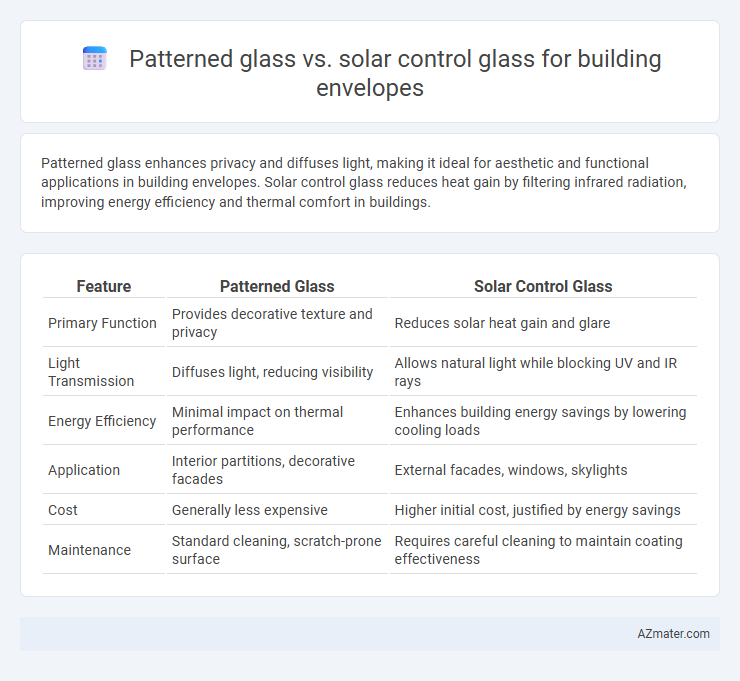Patterned glass enhances privacy and diffuses light, making it ideal for aesthetic and functional applications in building envelopes. Solar control glass reduces heat gain by filtering infrared radiation, improving energy efficiency and thermal comfort in buildings.
Table of Comparison
| Feature | Patterned Glass | Solar Control Glass |
|---|---|---|
| Primary Function | Provides decorative texture and privacy | Reduces solar heat gain and glare |
| Light Transmission | Diffuses light, reducing visibility | Allows natural light while blocking UV and IR rays |
| Energy Efficiency | Minimal impact on thermal performance | Enhances building energy savings by lowering cooling loads |
| Application | Interior partitions, decorative facades | External facades, windows, skylights |
| Cost | Generally less expensive | Higher initial cost, justified by energy savings |
| Maintenance | Standard cleaning, scratch-prone surface | Requires careful cleaning to maintain coating effectiveness |
Introduction to Building Envelope Glazing
Building envelope glazing plays a crucial role in energy efficiency and occupant comfort, where patterned glass offers decorative effects and diffuses natural light while maintaining privacy. Solar control glass incorporates advanced coatings to reduce solar heat gain, enhancing thermal performance and reducing cooling loads in buildings. Selecting between patterned glass and solar control glass depends on balancing aesthetic requirements with energy efficiency goals in architectural design.
What is Patterned Glass?
Patterned glass is a type of textured glass designed with various surface patterns to enhance privacy and diffuse light while maintaining visibility. Commonly used in building envelopes, patterned glass contributes to aesthetics and eliminates glare by scattering sunlight. Unlike solar control glass, which primarily reduces heat transmission and solar radiation, patterned glass focuses on light diffusion and decorative functionality.
What is Solar Control Glass?
Solar control glass is a specialized glazing designed to reduce solar heat gain while maximizing natural light transmission, enhancing energy efficiency in building envelopes. Unlike patterned glass, which primarily offers aesthetic design and privacy, solar control glass incorporates coatings or tints that reflect or absorb solar radiation to maintain indoor temperature comfort. This type of glass helps lower cooling costs and reduces reliance on air conditioning systems in commercial and residential structures.
Key Differences: Patterned vs Solar Control Glass
Patterned glass features textured or embossed surfaces that enhance privacy and diffuse light, making it ideal for aesthetic facades and interior partitions, while solar control glass incorporates special coatings to reduce solar heat gain and improve energy efficiency in building envelopes. Patterned glass primarily serves decorative and translucency functions without significantly altering thermal performance, whereas solar control glass actively manages infrared and ultraviolet radiation to maintain comfortable indoor temperatures and reduce cooling costs. The key difference lies in patterned glass's focus on light diffusion and design versus solar control glass's function in energy conservation and thermal regulation.
Light Transmission and Privacy Considerations
Patterned glass offers diffused light transmission, reducing glare while enhancing privacy by obscuring direct visibility, making it ideal for areas requiring moderate daylight with increased discretion. Solar control glass provides selective light transmission, significantly reducing solar heat gain and UV radiation without compromising clear vision, optimizing energy efficiency while maintaining comfort. Choosing between these glasses depends on balancing natural light penetration with privacy needs, where patterned glass favors privacy and solar control glass prioritizes thermal performance and clear visibility.
Energy Efficiency and Thermal Performance
Patterned glass enhances privacy and diffuses natural light but offers limited thermal insulation, which can lead to increased energy consumption for heating and cooling in building envelopes. Solar control glass incorporates coatings that reflect and absorb solar radiation, significantly reducing heat gain and improving energy efficiency by lowering cooling loads. Selecting solar control glass optimizes thermal performance, reduces reliance on HVAC systems, and contributes to sustainable building design.
Aesthetic Options and Design Flexibility
Patterned glass offers diverse textures and decorative designs that enhance facade aesthetics, providing architects with creative freedom to customize building exteriors. Solar control glass integrates advanced coatings that reduce solar heat gain while maintaining high light transmission, enabling energy-efficient designs without compromising visual clarity. Combining these materials in the building envelope allows optimal balance between aesthetic appeal and functional performance, supporting versatile architectural solutions.
Cost Comparison and Installation Factors
Patterned glass generally offers a lower upfront cost compared to solar control glass, making it a budget-friendly option for enhancing facades without specialized coatings. Solar control glass, equipped with advanced coatings to reduce heat gain and improve energy efficiency, incurs higher initial expenses but can lead to long-term savings on cooling costs. Installation complexity for solar control glass may require careful handling to preserve coating integrity, while patterned glass installation is more straightforward due to its uniform texture and durability.
Sustainability and Environmental Impact
Patterned glass enhances natural daylight distribution, reducing the need for artificial lighting and lowering energy consumption in building envelopes. Solar control glass minimizes solar heat gain, improving thermal insulation and decreasing HVAC energy demands, thereby contributing significantly to sustainability goals. Both glass types support environmental impact reduction by improving energy efficiency, but solar control glass typically offers superior performance in managing building temperature and carbon footprint.
Choosing the Right Glass for Your Building Envelope
Patterned glass enhances privacy and aesthetic appeal by diffusing natural light without compromising visibility, making it ideal for decorative or partition walls in building envelopes. Solar control glass improves energy efficiency by reducing heat gain and UV radiation, thus lowering cooling loads and increasing occupant comfort in hot climates. Selecting the right glass depends on balancing design requirements with energy performance goals to optimize both visual qualities and thermal management in the building envelope.

Infographic: Patterned glass vs Solar control glass for Building envelope
 azmater.com
azmater.com